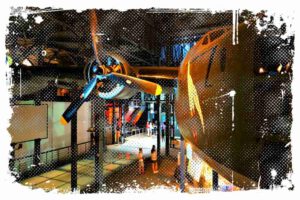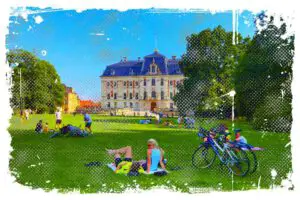Ever heard of UNESCO listed wooden churches in Małopolska? Well, you’ll find them in these small villages: Binarowa, Dębno Podhalańskie, Lipnica Murowana and Sękowa, as well as Haczów and Blizne in Podkarpackie Voivodeship

These churches represent the tradition of building medieval Roman Catholic churches using horizontal stacking of wooden logs, a technique popular throughout northern and eastern Europe in the Middle Ages. They were built by wealthy patrons. Today, they still impress visitors with their beautiful architecture and richly decorated interiors. In addition, you’ll experience the unique scent of incense and old wood, and enjoy the cool interior even on the hottest days. They’re all part of the Wooden Architecture Trail.
If you’re heading to Beskid Niski in the Magurski National Park, be sure to check out some of the amazing UNESCO-listed wooden churches (both former Orthodox and Lemko Orthodox) and others that may not be on the list but are still worth a visit, such as the Orthodox churches in Bartne, Chyrowa, Polany, Olchowiec, and Krempna (which is also in the park).
By the way, you may also be interested in checking out the article about the greatest Poland’s sites: Exploring Poland’s Cultural Riches: A Guide to UNESCO Cities
As you explore the park, you’ll also have the chance to come across a number of chapels, crosses, roadside statues, cemeteries from the First World War, Lake Zaporowe in Klimkówka, and even the graves of Jews murdered during the Second World War in the Halbow Pass.
The list of wooden churches in Malopolska included in the UNESCO World Heritage List:
Church dedicated to St. Michael the Archangel in Binarowa
It has a nave and a chapel of the Guardian Angels. It also has a choir and a tower with a pyramidal dome. The walls and roofs are covered with shingles. This adds to its charming appearance. There’s also a bell tower with a 15th century bell next to the church.
When you enter the church, you’ll be amazed by the beautiful decorations, especially on the ceiling, the choir and the nave. Among the most valuable artifacts are 14th century statues of saints and a Gothic stone baptismal font. All the furnishings in the church date from the 14th to the 17th century.
- Pictures and Google Maps Location: Here
Lipnica Murowana church dedicated to St. Leonard
Its construction dates back to the end of the 15th century and is still in use today. The church has a nave and presbytery with shingle roofs, as do the open arcades, called „sobotas”, that surround the temple.
Once inside, you’ll be amazed by the beautiful, richly decorated ceiling and walls from the 15th and 16th centuries. Unfortunately, the original altars were stolen, but they were recovered and placed in the Diocesan Museum in Tarnow. In the church you’ll find copies of them. There’s also a rare music box from the 17th century and an underground crypt with the grave of the Ledóchowski family. Overall, it’s a stunning place to visit and a piece of history well worth seeing.
- Pictures and Google Maps Location: Here
Church dedicated to Saints Philip and James in Sekowa
In the lush greenery of Beskid Niski, you’ll find another beautiful wooden church built in the early 16th century, but unfortunately it was destroyed during the First World War. This church was a favorite subject of famous Polish artists such as Wyspianski and Tetmajer.
The most remarkable features of this church is its low shingled roof and its square tower, which can be seen from close up, as well as the open arcades called „sobotas”. These arcades were intended for the pilgrims who came from far away to attend the mass but needed to stay for the night. The interior isn’t the most opulent, but it’s the simplicity of the church that makes it special. The main altar is late Renaissance. And don’t miss the 16th century stone baptismal font, a true treasure.
- Pictures and Google Maps Location: Here
Church dedicated to St. Michael the Archangel in Dębno Podhalański
The legend says that the temple was built by robbers to whom the archangel appeared, but there is no need to believe the legends so much. In reality, it was built in 15th century and its tower was added in the early 16th century. The temple is made of coniferous wood and consists of a nave, a choir with an adjoining sacristy, and a tower. The church is covered with shingles, except for the chamber of the tower, which is covered with boards.
As in all the previous churches, the interior is decorated with rich polychromy, created at the turn of the 15th and 16th centuries, using stencils called patrons. You can admire botanical, geometric, and figural motifs, hunting scenes, and a beautiful Jagiellonian eagle. The most valuable monuments in the church are the sculptures from the 14th century and the Gothic high altar.
- Pictures and Google Maps Location: Here
Bibliography
- https://pl.wikipedia.org/wiki/Ko%C5%9Bci%C3%B3%C5%82_%C5%9Bw._Micha%C5%82a_Archanio%C5%82a_w_Binarowej
- https://pl.wikipedia.org/wiki/Ko%C5%9Bci%C3%B3%C5%82_%C5%9Bw._Leonarda_w_Lipnicy_Murowanej
- https://pl.wikipedia.org/wiki/Ko%C5%9Bci%C3%B3%C5%82_%C5%9Bw.Filipa_i%C5%9Bw._Jakuba_w_S%C4%99kowej
- https://pl.wikipedia.org/wiki/Ko%C5%9Bci%C3%B3%C5%82_%C5%9Bw._Micha%C5%82a_Archanio%C5%82a_w_D%C4%99bnie




